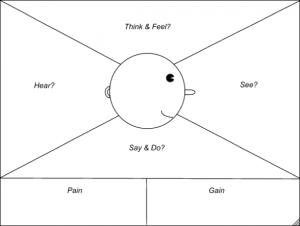Finding Product/Market Fit is one of the most important challenges faced by a startup. Here’s how we used Twitter to find a solution.
Product/Market Fit
Every startup begins with a vision.
There is no guaranteed way to verify your vision. No hypothetical market in which you can confirm whether you’re dreaming or having a delusion.
Focus groups and surveys rely on small samples of people. But small samples of people are unreliable and often can’t envision the use for a revolutionary new product.
Imagine …
- Why would anyone want to carry their whole music collection around in their pocket (iPod)?
- Why would anyone need a military technology in their phone (GPS)?
- What possible use could anyone have for a computer without a keyboard (iPhone)?
- Who would publish their personal diary for the world to see (Facebook)?
The answers seem obvious today, but there was a moment before these products were introduced when the answer wasn’t clear.
Selecting a sample of people who could foresee the benefit of these technologies is virtually impossible.
Until a product has been developed and the right customers have been introduced to the product, there is no way to bridge the gap between the potential and the actual reaction of the customer.
Product/Market Fit is a no man’s land that every startup enters and few survive.
Our Journey
MondoPlayer has a simple vision – to find and play videos from all over the web in a continuous stream.
It sounds like an easy proposition, but it’s actually very difficult. Videos exist on millions of websites with different architectures. Finding, indexing and playing these videos in a stream is very challenging.
A good friend of mine put it best when he asked me, “Why would anyone want to play video clips in a continuous stream?”
In a simple question, he had defined our product/market fit challenge.
In the end analysis, a technical capability is not a business. Unless users want this capability it has no intrinsic value.
Our goal is to find early adopters, the people who want this capability.
How Twitter Changed the Game
We needed a way to test a variety of vertical markets to gauge response. To see how the real world was organized in our market space and who would respond to our value proposition.
So we set up several Twitter accounts, each targeting a market niche and testing a hypothesis.
- Is MondoPlayer an “entertainment” product?
- Is MondoPlayer a “technology” that could be adapted to unknown uses?
- Is MondoPlayer a tool for people who are “news junkies” or “music buffs”?
- Is MondoPlayer a “content discovery” tool?
These are a sample of our tests, but in theory MondoPlayer is all of these things. What matters is whether the market agrees.
A Recipe for Product/Market Fit
- Set up a new Twitter Account for each market test. You will find it difficult to keep more than 4 or 5 accounts going at one time, so pick a small number of hypotheses. Think of each account as a person – an archetype.
- Create a profile for each Twitter Account designed to clearly speak to the test market represented by this archetype.
- Tweet regularly (5 to 10 times per day) with content targeted at each niche. You will need a Content Discovery tool to find enough content to tweet each day. You can find a list of tools here.
- Find hashtags that describe your target niche. Check the hashtags (using Hashtagify) before you use them to insure they will reach a large audience. Make sure you use 2 or 3 of these hashtags in every tweet, so Twitter users can find you.
- Follow Twitter users who use your selected hashtags in their Tweets. (There are many tools and services for this task.)
- Favorite Tweets containing your selected hashtags.
- Monitor the growth of your Twitter Accounts and the level of response. When you have several accounts going at once and you’ve tested 5 to 10 hypothesis, you will soon see a big difference between the markets that respond favourably and those that don’t.
As the old saying goes, “if you have to ask” you’re probably not looking at your target market. In my experience it takes about 2+ weeks to be sure you’re onto the right market niche.
Successful market niches will respond by following in much larger numbers and will be more inclined to interact on Twitter and with your website or blog.
Tips for Running your Tests
- Make sure your accounts all have photos of a person – NOT a corporate logo or the default “egg” that Twitter inserts when a Twitter account isn’t fully configured. Use different photos, but don’t use fake people.
- After the test you will want to keep the accounts that work. These will be important marketing channels/assets, so act accordingly.
- Create accounts that are associated with your Blog or Website. A lot of people are going to check out your service so they need a place to go and learn more.
- If you’re marketing an App, this is a great way to find Beta users and users who are interested in upcoming releases.
- You will get more unsolicited feedback on these accounts than on any other tool, so pay attention to the Direct Messages you get.
- Set up an automatic DM service that thanks users when they follow the account. This will increase the number of people returning to your profile.
Twitter is a low cost way to meaningfully test your product in a lot of markets in a short time. Unlike a focus group or a survey, these are real potential customers who can interact with you and provide valuable feedback.
(204)
Report Post



